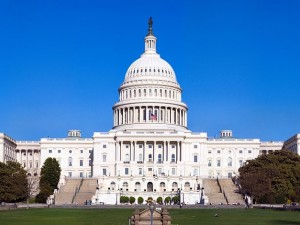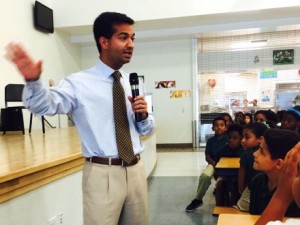
“We helped build a green wave of turnout from climate voters, and now politicians are scrambling to appeal to them by putting climate leadership front and center,” said EVP Founder and Executive Director Nathaniel Stinnett.
By Steve Valk
At Citizens’ Climate Lobby, we often say the solution to climate change is democracy. Well, the first step to engage with our democracy is voting. Research shows, however, that many who are concerned about the state of our climate don’t even take that initial step. In fact, tens of millions of people who identify as environmentalists have been no-shows at the polls on election day.
The problem with this lack of voting by the climate-concerned is that it sends the message to politicians that they need not prioritize climate change as a problem to be solved. Bottom line: If you don’t vote, elected officials aren’t likely to worry about the things that keep you up at night.
Enter Nathaniel Stinnett with the solution to this problem. Armed with knowledge and experience from numerous political campaigns, Stinnett started the Environmental Voter Project in 2015 with the mission to mobilize environmentalists they identify as inactive voters, information that is available in public records.
It appears now that EVP’s work had a major impact on the 2020 elections and, by extension, a big impact on the prospects for climate action in the near future.
For the record, both Citizens’ Climate Lobby and Environmental Voter Project are nonpartisan. Neither organization tells people who to vote for. That said, for those who consider climate change a top priority, the choice in the 2020 presidential election was between a candidate who laid out an ambitious plan to address climate change (Joe Biden) and a candidate who never mentioned it, or indeed took steps to reverse progress (Donald Trump). Environmentalists motivated to vote by EVP, in all likelihood, were inclined to vote for Biden.
EVP’s impact in the general election
Looking at the numbers, EVP played a big role in putting the climate-friendly candidate in the White House. Biden’s win in the electoral college hinged on the outcome in a few closely contested states where EVP reached out to environmentalists, many of whom were first-time voters. Information on environmental voters who voted on election day is not yet available, but here are the figures in battleground states for the early voters EVP contacted and Biden’s margin of victory in those states:
- 54,976 new environmental voters cast early ballots in Pennsylvania, where Biden won by 81,660 votes
- 56,990 new environmental voters cast early ballots in Arizona, where Biden won by 10,457 votes
- 69,332 new environmental voters cast early ballots in Georgia, where Biden won by 11,779 votes
- 20,705 new environmental voters cast early ballots in Nevada, where Biden won by 33,596 votes
Credit for voter turnout must be given to many organizations, not the least of which is Stacey Abrams’ Fair Fight. But it’s clear that EVP’s efforts made a big contribution.
EVP impacted the Georgia runoffs, too
Biden’s win ushers in a new era of urgency to address climate change, but options for solving the crisis would be limited if control of the Senate had not shifted to the Democrats, whose leadership is more inclined to bring climate legislation to the floor. Back in December, the chances of that shift happening depended on Democratic candidates winning two runoff elections in Georgia on Jan. 5. One month out, oddsmakers were leaning toward the Republicans retaining control of the Senate.
To the surprise of many, the Democrats won both seats, with Raphael Warnock defeating Sen. Kelly Loeffler by 93,272 votes and Jon Ossoff defeating Sen. David Perdue by 54,944 votes.
Again, many organizations share credit for the turnout that gave victories to Warnock and Ossoff, and again EVP’s contribution seems to have been critical.
Organizing Director Shannon Seigal reports that EVP targeted 382,844 unlikely-to-vote environmentalists in the Georgia runoffs. “Of these unlikely voters, we know that 115,381 voted before election day, including 6,701 voters who didn’t even vote in the general election. For that campaign, we made 825,007 phone calls, sent 1.1 million text messages, sent 538,106 pieces of direct mail, and made 12.7 million digital ad impressions.”
Figures for voting on the day of the election won’t be available until next month, so the number of voters EVP helped to turn out is expected to go higher. Though we can’t assume that all these voters chose Warnock and Ossoff, it’s likely that a high percentage of them opted for the candidates who placed a higher priority on addressing climate change.
CCL volunteers contributed to these EVP achievements
For Stinnett, the general election and Georgia runoffs were a validation of EVP’s work. “2020 was the perfect proof point for the Environmental Voter Project’s efforts. We helped build a green wave of turnout from climate voters, and now politicians are scrambling to appeal to them by putting climate leadership front and center,” Stinnett said in a statement.
“And despite all of 2020’s political turmoil, this one constant still remains: nothing motivates a politician more than the prospect of winning or losing an election,” Stinnett added. “It’s crucially important for climate voters to continue building our political power and flood the polls in local and state elections throughout 2021.”
With a staff of only four, EVP relied heavily on a team of 6,439 volunteers who received online training to participate in virtual phone and text banks. Hundreds of Citizens’ Climate Lobby volunteers contributed to the effort. “CCL volunteer leaders from across the country — especially San Francisco, Los Angeles, Hudson Valley New York, Washington, D.C., and North Atlanta — were integral to making those trainings and events happen and run smoothly,” said Seigal.
One of those CCL volunteers was North Atlanta chapter leader Jeff Joslin, a Delta Airlines pilot who, because of the pandemic’s economic carnage, opted for early retirement in 2020. A veteran of previous EVP campaigns, including the 2018 midterm elections, Joslin organized a team of 30 volunteers.
“I went door-to-door in 2018, but this year it was all on the telephone. The calls were non-partisan. We’d ask if they signed up for early voting and provide information on how to vote early. If they brought up a candidate or party they didn’t like, we kind of side-stepped that,” said Joslin.
What’s next for EVP
EVP won’t be content to rest on their laurels. There are still millions of environmentalists who haven’t “graduated” to become consistent voters, and Seigal says they plan to continue to get people to the polls in local elections.
“It’s very hard to build a habit if we only contact people every two or four years. Instead, we are contacting voters right now to remind them about local and special elections they have coming up. Once someone starts voting consistently and it becomes a habit, they are much more likely to keep voting and to become even more politically engaged going forward.”
As the year progresses and momentum builds to enact climate solutions, we may see members of Congress from both sides of the aisle stepping up who have previously been on the sidelines. When that happens, give a tip of the hat to Environmental Voter Project.




